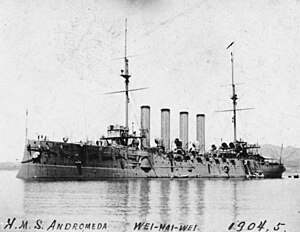HMS Andromeda (1897)

| |
| History | |
|---|---|
| Name | Andromeda |
| Namesake | Andromeda |
| Builder | Pembroke Dockyard |
| Laid down | 2 December 1895 |
| Launched | 30 April 1897 |
| Completed | 5 September 1899 |
| Renamed |
|
| Reclassified | As a training ship, 23 September 1913 |
| Fate | Sold for scrap, 1956 |
| General characteristics | |
| Class and type | Diadem-class protected cruiser |
| Displacement | 11,000 long tons (11,177 t) |
| Length | 435 ft (132.6 m) (p/p) |
| Beam | 69 ft (21.0 m) |
| Draught | 25 ft 6 in (7.8 m) |
| Installed power |
|
| Propulsion |
|
| Speed | 20.5 kn (38.0 km/h; 23.6 mph) |
| Complement | 677 |
| Armament |
|
| Armour | |
HMS Andromeda was one of eight
Design and description
The Diadem class was designed to protect British merchant shipping from fast
The main armament of the Diadem-class ships consisted of 16
The sloped armoured
Construction and career
Andromeda was the fifth ship of her name to serve in the Royal Navy
Upon completion on 5 September 1899, she was assigned to the Mediterranean Fleet. In March 1900 she did a month's cruise of Italian and Spanish ports. then transferred to the dockyard for a lengthy refit.
Andromeda was assigned to the China Station in 1904 and returned home three years later. The ship was reduced to reserve at Chatham Dockyard upon her return, but transferred to Devonport Dockyard shortly afterwards. In 1907 Lieutenant Quentin Crauford was authorised by the Admiralty to create an experimental radio station to broadcast to the fleet in Chatham – and this was the first wireless broadcast of music and speech for the purpose of entertainment in Britain.[19][20][21]Andromeda was assigned to the 9th Cruiser Squadron of the new reserve Third Fleet in 1912. The following year the ship was converted to a boys' training ship[22] and renamed Powerful II on 23 September 1913.[9] She was later renamed Impregnable II in November 1919 and finally, HMS Defiance on 20 January 1931,[9] when she became part of the torpedo school.[22] The ship was sold for scrap in 1956 and arrived at Burgt, Belgium, on 14 August to begin demolition.[23]
Notes
- ^ "Cwt" is the abbreviation for hundredweight, 20 cwt referring to the weight of the gun.
Citations
- ^ Phillips 2014, p. 259.
- ^ McBride 1987, p. 211.
- ^ Chesneau & Kolesnik 1979, p. 68.
- ^ Phillips 2014, pp. 214–15.
- ^ a b c d e f g Chesneau & Kolesnik 1979, p. 5.
- ^ Phillips 2014, p. 215.
- ^ a b c Phillips 2014, p. 15.
- ^ Phillips 2014, pp. 213–14.
- ^ a b c Colledge & Warlow 2006, p. 15.
- ^ Phillips 2014, pp. 258–59.
- ^ "Naval & Military intelligence". The Times. No. 36089. London. 14 March 1900. p. 7.
- ^ "The Duke of Cornwall´s visit to the colonies". The Times. No. 36401. 13 March 1901. p. 5.
- ^ "Naval & Military intelligence". The Times. No. 36724. 25 March 1902. p. 9.
- ^ "Naval & Military intelligence". The Times. No. 36792. 12 June 1902. p. 13.
- ^ "Naval & Military intelligence". The Times. No. 36778. 27 May 1902. p. 10.
- ^ "The Coronation - celebrations in the colonies". The Times. No. 36801. 23 June 1902. p. 10.
- ^ "Naval & Military intelligence". The Times. No. 36896. London. 11 October 1902. p. 11.
- ^ "Naval & Military intelligence". The Times. No. 36980. London. 17 January 1903. p. 9.
- ^ Webb, Simon (2018), The Analogue Revolution: Communication Technology, 1901–1914 , Pen & Sword Books.
- ^ Tucker, S. D. (2015), Great British Eccentrics, Amberley Publishing
- ^ Bathgate, Gordon. (2020) Radio broadcasting a history of the airwaves., Pen and Sword History (see page 18)
- ^ a b Friedman 2012, p. 233.
- ^ Phillips 2014, p. 9.
References
- Chesneau, Roger; Kolesnik, Eugene M., eds. (1979). Conway's All the World's Fighting Ships 1860-1905. Greenwich, UK: ISBN 0-8317-0302-4.
- OCLC 67375475.
- Friedman, Norman (15 November 2012). British Cruisers of the Victorian Era. Barnsley, South Yorkshire, UK: ISBN 978-1-59114-068-9.
- McBride, Keith (October 1987). "The Diadem Class Cruisers of 1893". ISSN 0142-6222.
- Phillips, Lawrie; Lieutenant Commander (2014). Pembroke Dockyard and the Old Navy: A Bicentennial History. Stroud, Gloucestershire, UK: ISBN 978-0-7509-5214-9.)
{{cite book}}: CS1 maint: multiple names: authors list (link
External links
